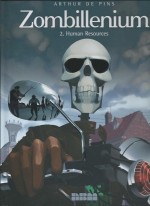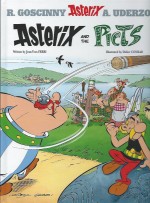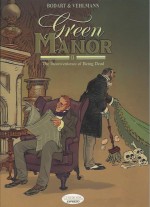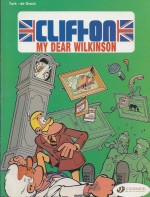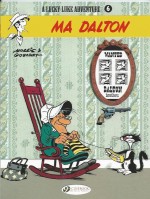
By Morris & Goscinny, translated by Frederick W. Nolan (Cinebook)
ISBN: 978-1-905460-14-4
It’s hard to think of one of Europe’s most beloved and evergreen comics characters being in any way controversial, but when changing times caught up with the fastest gun in the West (“so fast he can outdraw his own shadowâ€) and the planet’s most laconic cowboy moved with them, the news made headlines all over the world.
Lucky Luke is a rangy, good-natured, lightning-fast cowboy who roams the fabulously mythic Old West, having light-hearted adventures with his sarcastic horse Jolly Jumper and interacting with a host of historical and legendary figures. His continued exploits over nearly seventy years have made him one of the best-selling comic characters in Europe (over 80 collected books and more than 300 million albums in 30 languages thus far), with the usual spin-off toys, computer games, animated cartoons and a plethora of TV shows and live-action movies.
He was created in 1946 by Belgian animator, illustrator and cartoonist Maurice de Bévère (“Morrisâ€) and was first seen the 1947 Annual (L’Almanach Spirou 1947) of Le Journal de Spirou, before launching into his first weekly adventure ‘Arizona 1880’ on December 7th 1946.
Prior to that, while working at the CBA (Compagnie Belge d’Actualitiés) cartoon studio, Morris met future comics superstars Franquin and Peyo, and joined weekly magazine Le Moustique as a caricaturist – which is probably why (to my eyes at least) his lone star hero looks uncannily like the young Robert Mitchum who graced so many memorable mid-1940s B-movie Westerns.
Morris quickly became one of la Bande des quatre or “The Gang of Four†comprising Jijé, Will and his old comrade Franquin: the leading proponents of the loose, free-wheeling artistic style known as the “Marcinelle School†which predominated in Spirou in aesthetic contention with the “Ligne Claire†style used by Hergé, EP Jacobs and other artists on Tintin Magazine.
In 1948 said Gang (all but Will) visited the USA, meeting American comics creators and sightseeing. Morris stayed for six years, linking up with fellow traveller René Goscinny, scoring some work from the newly-formed EC sensation Mad and making copious notes and sketches of the swiftly vanishing Old West.
That research would resonate on every page of his life’s work.
Working solo until 1955, Morris produced another nine albums worth of affectionate sagebrush spoofery before reuniting with Goscinny, who became the regular wordsmith as Luke attained the dizzying heights of superstardom, commencing with ‘Des rails sur la Prairie’ (Rails on the Prairie), which began in Spirou on August 25th 1955.
In 1967 the six-gun straight-shooter switched sides, transferring to Goscinny’s own magazine Pilote with ‘La Diligence’ (The Stagecoach). Goscinny eventually produced 45 albums with Morris before his untimely death, from whence Morris continued both singly and with fresh collaborators.
Morris himself died in 2001 having drawn fully 70 adventures, plus some spin-off sagas crafted with Achdé, Laurent Gerra, Benacquista & Pennac, Xavier Fauche, Jean Léturgie, Jacques Pessis and others all taking a crack at the venerable franchise…
Moreover, apart from that very first adventure, Lucky (to appropriate a quote applied to the thematically simpatico TV classic Alias Smith and Jones) “in all that time… never shot or killed anyoneâ€â€¦
Lucky Luke first appeared in Britain syndicated to weekly comic Film Fun during the late 1950s and once again in 1967 in Giggle where he was renamed Buck Bingo. In all these venues – as well as the numerous attempts to follow the English-language successes of Tintin and Asterix albums – Luke had a trademark cigarette hanging insouciantly from his lip. However in 1983 Morris, no doubt amidst both pained howls and muted mutterings of “political correctness gone madâ€, deftly substituted a piece of straw for the much-travelled dog-end, which garnered him an official tip of the hat from the World Health Organization.
The most recent and successful attempt to bring Lucky Luke to our shores and shelves comes from Cinebook (who have rightly restored the foul weed to his lips on the interior pages, if not the covers…) and Ma Dalton was the sixth of their 54 (and counting) albums, now available both on paper and as e-books.
Chronologically it was the cowboy’s 38th chronicle and Goscinny’s 29th collaboration with Morris, offering an engagingly riotous romp and a stupendously shocking showdown situation wherein all the laconic lawman’s legendary speed proved as nothing when facing a foe he could not draw against…
It all begins after another suitably heroic escapade with our hero is relaxing in boisterous Cactus Junction when he stumbles upon the strangest hold-up he’s ever seen, as a little old lady holds up the local butcher at gunpoint and gets away with a steak and some scraps for her cat. Baffled, he tracks her to the store next door where a similar scenario occurs.
On questioning the shopkeepers Luke is informed that proud old Ma Dalton has fallen on hard times and the sympathetic merchants have all agreed – even though her creaky old six-gun doesn’t work – to let her “rob†them whenever she runs out of the necessities of life such as tea, soap, food and scraps for her horrible cat “Sweetieâ€â€¦
And yes, the engaging old biddy is indeed the mother of Luke’s intolerable arch-enemies: those vile owlhoot miscreants Averell, Jack, William and their devious, slyly psychotic, overly-bossy shorter brother Joe…
Sadly, Ma isn’t as sweet as everybody thinks. She knows full well what the infamous Dalton Gang are all about. Her lads are still in jail after the last time the tall busybody put them there, but as she writes them a letter they are again making a break for it. It’s easier than usual this time since the prison is a multi-story affair made mostly from wood…
As it burns to the ground the warden thinks he’s pretty smart chaining Joe to faithful prison hound Rin Tin Can but has forgotten that the vain, friendly and exceedingly dim pooch is utterly loyal to absolutely everybody.
The outraged authoritarian only realises his mistake when the boys abscond, taking the deliriously unresisting mutt with them…
After his introduction in 1962’s Sur la piste des Dalton, (On the Daltons’ Trail) Rantanplan – “dumbest dog in the West†and a wicked parody of cinema canine Rin-Tin-Tin – became an irregular feature in Luke’s adventures before eventually landing his own spin-off series title. The moronic mutt earns his spurs here, being a literal drag on the villains’ progress until he tries chasing Sweetie after the boys sneak home. Ma however is a stern and commanding pet owner who paralyses the pooch with one curt command…
As they lay low, old family pressures build again at the Dalton shack. Dim, sneaky Averell was always Ma’s favourite and as he again sops up all her attention Joe, Jack and William settle upon a scheme to make some cash whilst they’re hiding out. It revolves around the fact that Daltons all look remarkably similar and, once the moustaches are off and they’re wearing her old dresses, the boys can pass for their mum in any shop or bank in the region with Lucky Luke none the wiser…
However when Averell starts joining in and queering the guileful gig, the “old dear†is seen in stores miles apart in Alfalfa City and Tumbleweed Town, swiping cash and guns rather than vegetables and soap, and the canny cowboy quickly puts two and two together…
Soon the infamous family are on the run with Lucky and Jolly Jumper hard on their heels. But it’s guile and not gunplay that will win the day since nobody expects the gangling gunfighter to draw down on a little old lady. She just might end up as “the one who got awayâ€â€¦
Fast-paced, seductive slapstick and wry cynical humour colour this splendidly mad ride: another grand old hoot in the tradition of Destry Rides Again and Cat Ballou, superbly executed by master storytellers and providing a wonderful introduction to a unique genre for today’s kids who might well have missed the romantic allure of an all-pervasive Wild West that never was…
© Dargaud Editeur Paris 1971 by Goscinny & Morris. © Lucky Comics.

